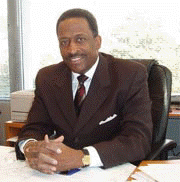


Mention the name "Eisenhower" and
most folks will associate it with the dyed-in-the-wool Republican who became the
nation's 34th president.
President Dwight David Eisenhower was a former military man who could never be
mistaken for a liberal. Yet, there are lots of liberal ideas that are being
generated under the Eisenhower name. And one of those ideas might wind up right
here in Baltimore. How could this happen? To find out, I went to Washington.
At 1875 Connecticut Ave. NW, I found the Milton S. Eisenhower Foundation.
It's named after Milton Stover Eisenhower, Ike's younger brother, who at various
times was himself a president -- of Kansas State, Pennsylvania State and the
Johns Hopkins universities.
Milton S. Eisenhower's views and achievements are overshadowed by those of his
more famous brother. It's often forgotten that he served as chairman of the
National Commission on the Causes and Prevention of Violence in 1968-1969.
The foundation was formed in 1980 by Milton Eisenhower and others who served on
the commission he headed or on the National Advisory Commission on Civil
Disorders (also known as the Kerner Commission) -- including Judge A. Leon
Higginbotham, former Massachusetts Sen. Edward Brooke, former Attorney General
Nicholas Katzenbach and Dr. Alan Curtis, the foundation's president and
chief executive officer,
Folks at the foundation "look at issues of poverty and race," said Leila
McDowell, director for Capacity-Building Replications and its former Director
for Communications.
According to the foundation's Web site, it is "devoted to reducing inequality
and poverty, enhancing opportunity and justice, redistributing money and power,
and moderating the corruption and greed present in American democracy."
Yes, yes, I know. That little phrase "redistributing money and power" might
cause you to think the foundation is a just a little bit commie. But it really
isn't.

Some of that "redistributed" money
the foundation redistributes itself -- to programs that have been found
effective.
"We do a scientific evaluation of what works and what doesn't work," McDowell
said.
"Our policy is to fund what works
rather than what doesn't work." Once a program works, foundation members try to
replicate it in other parts of the country.
One of the things they are absolutely convinced works is a San Francisco
foundation called Delancey Street, which they want to bring to Baltimore.
Started 30 years ago, Delancey Street brought together a group of ex-convicts
and drug addicts who lived together with no supervisory staff. (Boy, no wonder
the thing worked.)
Delancey Street residents live in a building constructed with their own labor.
Some entered the program without even a high school education and left not only
with GEDs but close to getting college degrees.
Delancey Street takes in $5 million a year from its businesses, which include a
restaurant and a moving company. The focus is on education and vocational
training.
The program receives no government funding.
Yes, you read that correctly. All of Delancey Street's money comes from revenue
generated by the program's businesses. Hey, with no supervisors and no
government officials sticking their noses in it, the program is a surefire
winner, right?
 "For
me, the most exciting piece of that is the ability for [Delancey Street] to be
self-governing," said Johnnie Gage, chief operating officer at the
Eisenhower Foundation. Gage should know. It wasn't that long ago that he was a
recovering addict himself, in Portland, Ore. After Gage started on what he
called "the wonderful road to recovery," he and several others started Stay
Clean, a program for Portland's addicts and ex-convicts that was strikingly
similar to Delancey Street.
"For
me, the most exciting piece of that is the ability for [Delancey Street] to be
self-governing," said Johnnie Gage, chief operating officer at the
Eisenhower Foundation. Gage should know. It wasn't that long ago that he was a
recovering addict himself, in Portland, Ore. After Gage started on what he
called "the wonderful road to recovery," he and several others started Stay
Clean, a program for Portland's addicts and ex-convicts that was strikingly
similar to Delancey Street.
Gage went on to become an assistant to the city commissioner in Portland before
he headed east and landed a part-time job at the Eisenhower Foundation. He soon
worked his way up to Chief Operating Officer. He and other foundation workers
are certain that Delancey Street can be replicated in Baltimore.
That remains to be seen. But McDowell provided an ominous message that gives us
the incentive for us to give it a try:
"Fifty-nine percent of those paroled from Maryland's prisons will return to
Baltimore," she said.
Curtis gives Milton credit for drafting Ike's farewell speech as president, the
one in which he warned about the military-industrial complex.
Fifty-nine percent of the state's parolees -- that's a lot of folks returning to
a troubled city who'll be unemployed and unemployable. And perhaps it's time for
someone to sound a new warning. Without efforts like Delancey Street, society
faces a new danger -- this time it's the prison-industrial complex.